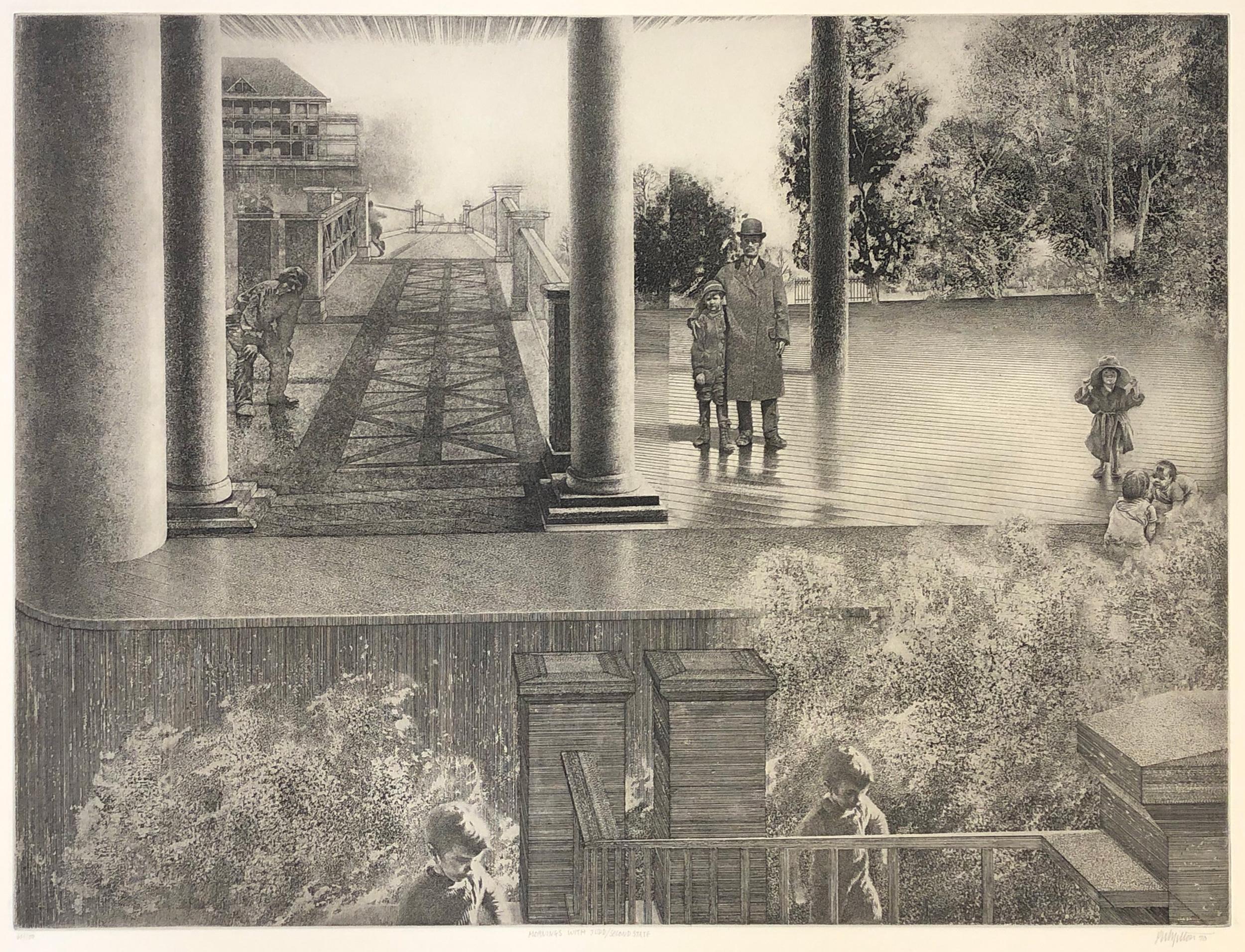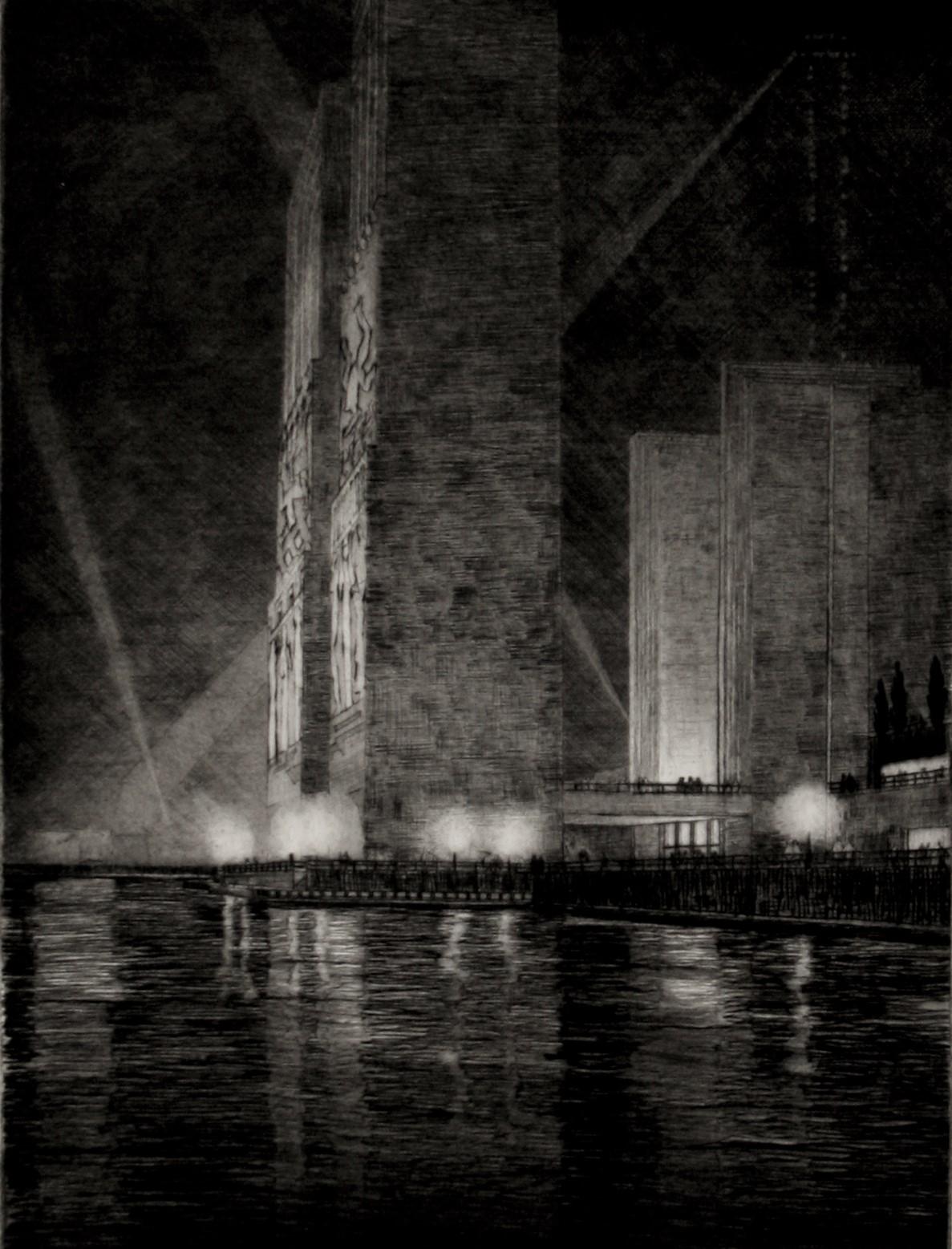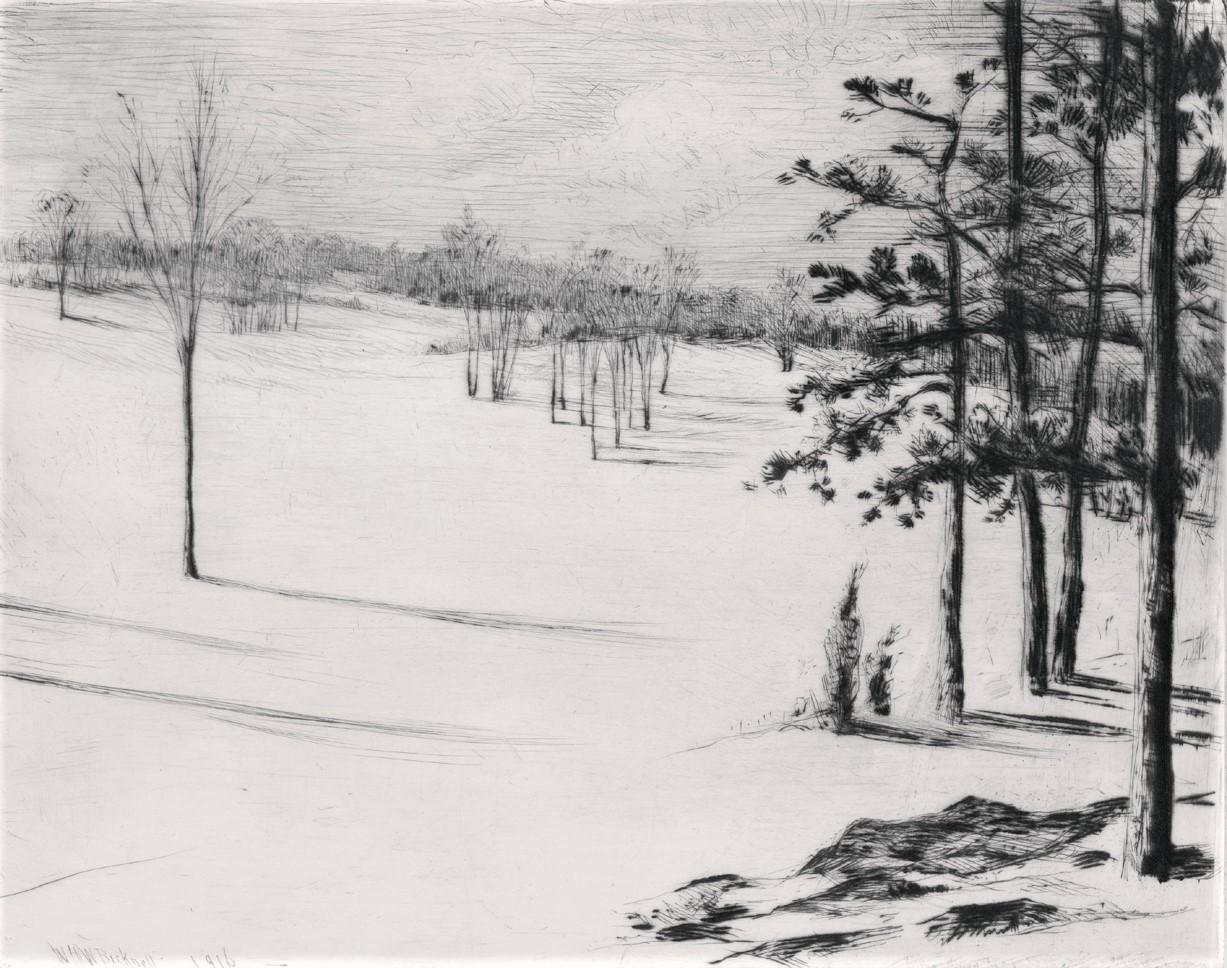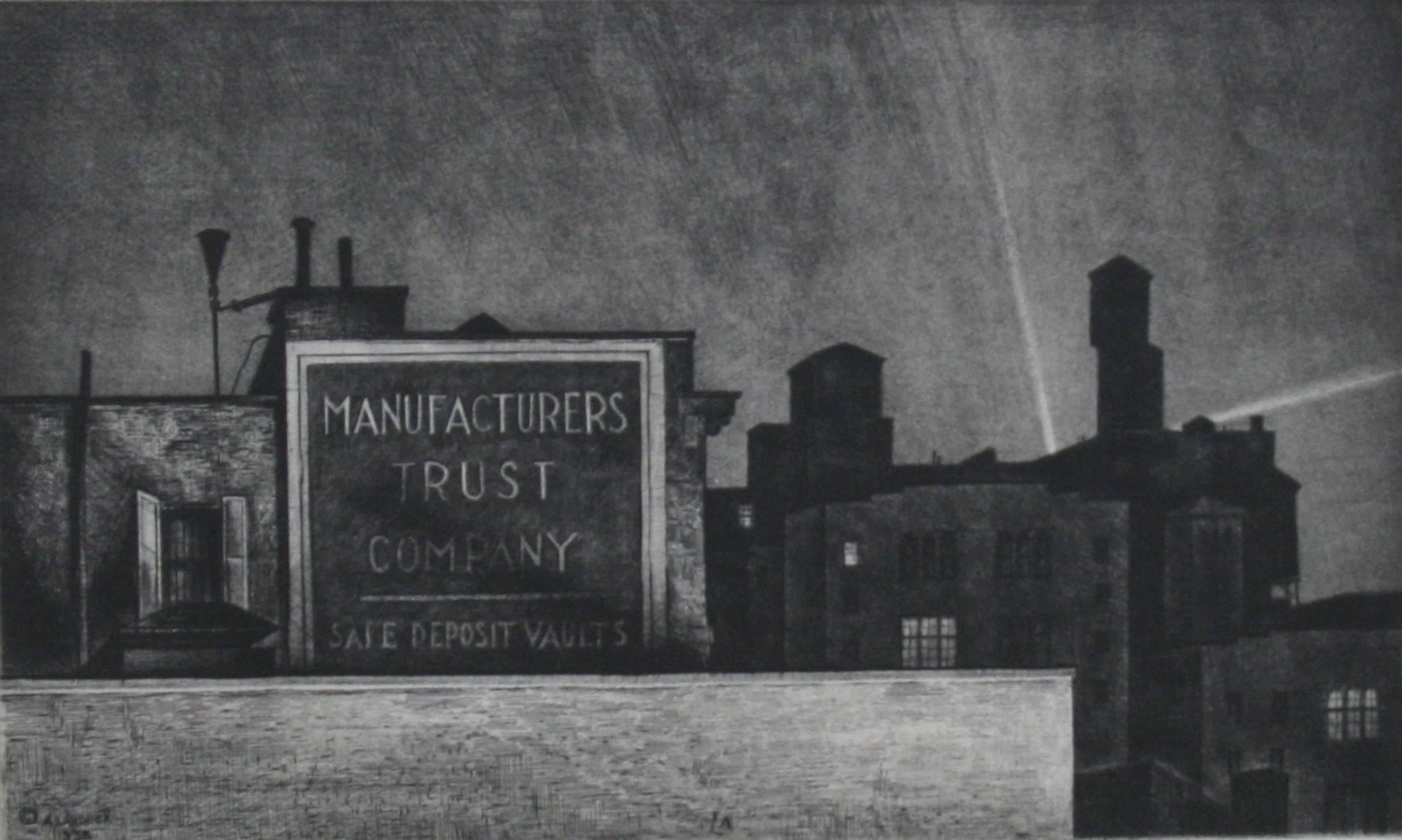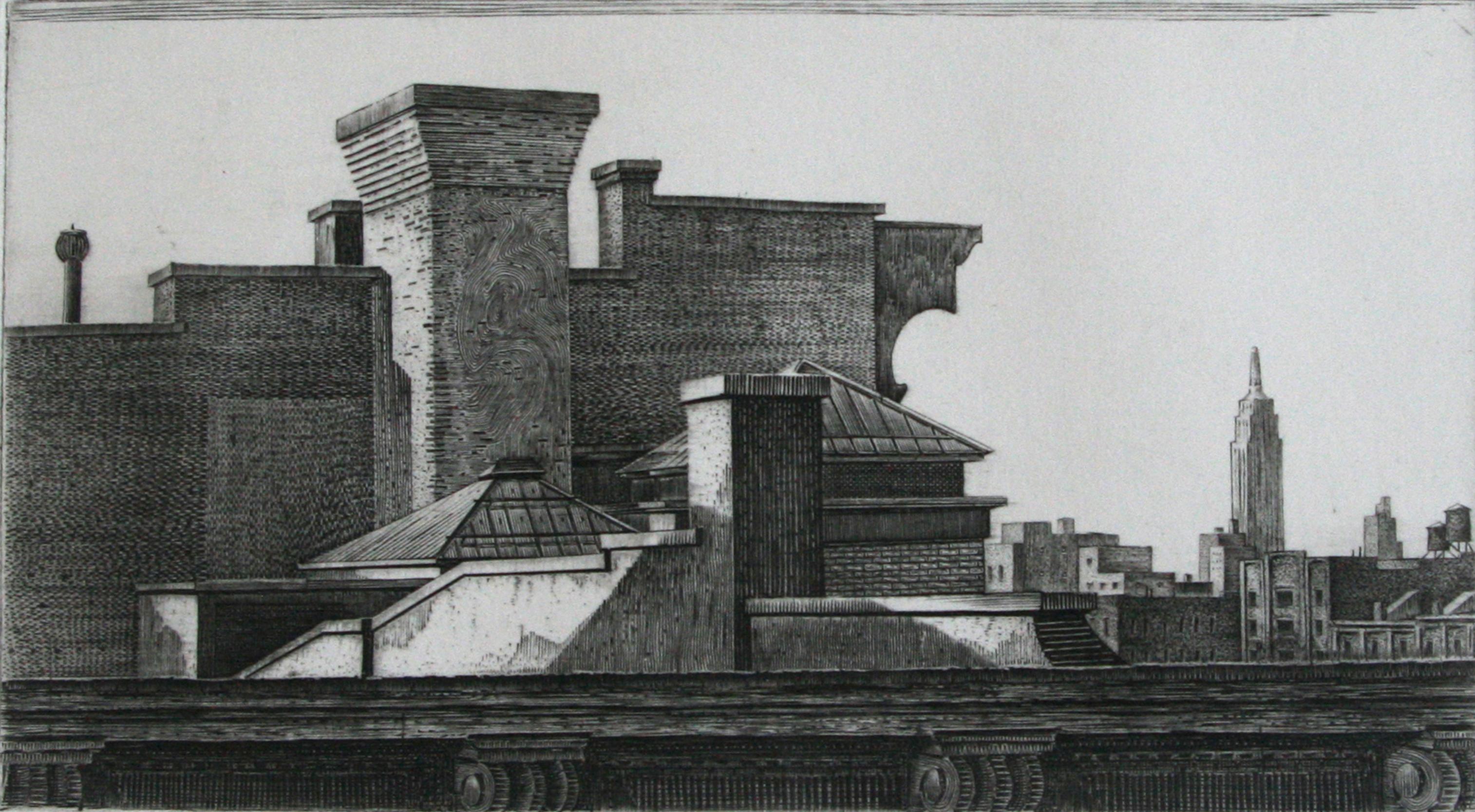Items Similar to 'Tribal Coast', Expressionist Woman artist, Museum of Modern Art, Guggenheim
Want more images or videos?
Request additional images or videos from the seller
1 of 16
Ynez Johnston'Tribal Coast', Expressionist Woman artist, Museum of Modern Art, Guggenheim 1964
1964
About the Item
Signed lower right, 'Ynez Johnston' (American, b. 1920) and dated 1964; additionally inscribed 'imp' lower right, titled lower center 'Tribal Coast' with number and limitation, 198/210', lower left.
Framed Dimensions: 21.25 H x 26.5 W x 1.5 D Inches
Born in Berkeley, California, Johnston first studied drafting, painting and printmaking at the University of California with Worth Ryder, Erle Loran and Margaret Peterson. Her work is characterized by "jigsaw" shapes reminiscent of primitive, tribal designs. This unique style blends modernism and ancient art forms from her travels to Italy, Mexico, India and Nepal. She has also undertaken 3-dimensional pieces in collaboration with her husband, poet and novelist John Berry, as well as with ceramic sculptor Adam Mekler.
Johnston's 1951, one woman show at the Museum of Modern Art in New York created significant public interest in her work and initiated her career as a successful artist. Her oils and etchings of the 1950s and 1960s became more ambitious in their use of complex imagery while displaying a consistently disciplined and harmonised use of color.
In later mixed-media pieces, Johnston examines the tactile qualities of surface. The paintings involve the combination, and occasional lamination, of diverse material soil, acrylic, dyes, encaustic on cloth, canvas, and raw silk. The colors are vibrant and the images are composite forms suggesting ambiguous architectural, human, animal and plant shapes. She cites Persian and Indian art as influences along with such artists as Matisse, Miro, Klee and Picasso.
Johnston has been the recipient of numerous awards and fellowships including a grant from the National Endowment for the Arts and a Guggenheim Memorial Foundation Fellowship. She has exhibited widely and with success, winning a variety of medals, prizes and juried awards including First Prize in watercolor at the Metropolitan Museum of Art (1952). She has also exhibited at the San Francisco Museum of Art, and at Mitsukoshi in Tokyo. Her work is held in the permanent collections of museums nation-wide including of the Museum of Modern Art and the Metropolitan Museum of Art, in New York City and the Los Angeles County Museum among others.
Reference:
Who Was Who in American Art 1564-1975: 400 Years of Artists in America, Peter Hastings Falk, Sound View Press 1999, Vol. 2, p. 1752-1753; Les Krantz, American Artists, Illustrated Survey of Leading Contemporary Artists; Elenore Welles, 'Ynez Johnston', Farhat Cultural Center website; et al.
Additional biographical information courtesy of Tobey C. Moss Gallery, West Hollywood:
Ynez Johnston is an architect of fantastic realms. Though she may skirt reality, she never quite eliminates the concrete, merely disguises it. Her idiosyncratic vocabulary of forms derive from a collective cultural history. But references metamorphose into a unique fusion of elements that show no regard for the actual physical world.
Throughout her career, Johnston has experimented with a variety of mediums that include etchings, lithography, oils, watercolor, paper maché, ink dyes, sumi on rice paper and casein. Crucial to her inventive composites are the influences of Mogul and Tibetan artists, Pre-Columbian stone carvings, artists such as William Blake, and the obsessive proclivities of Persian paintings. The melding of sources suggest a line between cubism, European surrealism and the over-all qualities of American abstract expressionism. Her personal evocations of abstract geometry are particularly reminiscent of the fanciful linear styles of Paul Klee and Mark Tobey.
By combining mythic designs with the precepts of modernism, she evokes hybrids of universal forms and familiar landmarks. But they evolve strictly out of Johnson's fertile imagination. . . a synthesis of outer and inner visions. As though spilling out of an overcrowded subconscious, a multitude of geometric forms and shapes transmute into intricate designs. Palace of the Snow Leopard [1971], for example, is dominated by a form that looks like a cross between animal and architecture. The stylized figure bears a conglomeration of colorful designs and symbols. It appears a strange hybrid of a Mayan stylized animal and a Chinese horse. It is pure contrivance.
A fifty-year survey reveals how Johnston's stylistic developments have gone through cycles and mutations. But the vitality of her colors remain prevalent, and certain forms and themes have a continuous life span. The repetition of mythic shapes, particularly a mandala-like form, strengthen the enduring psychological power of ancient myths.
Mythical urban landscapes also remain a constant throughout her oeuvre. In Arabia [1960] her abstract depiction of crowded environs recall the surreal urban representations of Philip Guston. Through time, however, her evocative worlds become denser and more exotic. In Expedition [1989] shapes resemble castles, temples, humans, animals and illusive symbols. I say "resemble" because this is a purely invented world. The use of black against vivid greens, golds and orange create a cohesive bond for the disparate images.
The Green Nile [1998] is replete with familiar Johnston elements. Here again, dazzling colors activate the relationship between man, cities, nature and symbols. Whimsical violet pyramids and middle-eastern architecture suggest cities in the sand. A green diamond-shaped island is set off by a sea of vivid blue, and a bright golden ground provides emphasis for a Mayan-type design. Surrounding shapes, set within fields of orange, red and yellow, evoke a pulsating energy.
The influence of Tibetan tanka paintings and their penchant for borders is reflected in Sailing Around the Horn. Created with ink dyes on canvas and silk, fanciful depictions are set within borders of yellow, aqua and deep turquoise.
Sculptures also show a propensity for hybrids. In the 1992 bronze, The Woman Who Waits by the Sea, Pre-Columbian and Asian influences appear prominently. A stylized woman stands upon a dog-like figure. Both are etched with a sundry amount of designs and figures.
Johnston's horror-vacuii style demands quite a bit of examination. But her amalgamation of images can extend the imagination of the spectator. Enigmatic forms rooted in ambiguous space give the illusion of dream metaphors. Juxtapositions that evoke associative meanings can transport viewers into their own fantasy universes.
- Creator:Ynez Johnston (1920 - 2019, American)
- Creation Year:1964
- Dimensions:Height: 11.5 in (29.21 cm)Width: 17.75 in (45.09 cm)Depth: 0.01 in (0.26 mm)
- Medium:
- Movement & Style:
- Period:
- Condition:paper: age-toning; frame: minor toning to mat, minor marks. This piece will ship without glass.
- Gallery Location:Santa Cruz, CA
- Reference Number:1stDibs: LU3444387732
About the Seller
5.0
Platinum Seller
These expertly vetted sellers are 1stDibs' most experienced sellers and are rated highest by our customers.
Established in 1982
1stDibs seller since 2013
Typical response time: <1 hour
- ShippingRetrieving quote...Ships From: Santa Cruz, CA
- Return PolicyA return for this item may be initiated within 3 days of delivery.
More From This SellerView All
- 'Monterey at Sunset', California Post-Impressionist LandscapeBy John MaxonLocated in Santa Cruz, CAA substantial trillium monotype landscape showing a view of the cultivated fields and coastal hills of Monterey County, California bathed in the glow of a radiant sunset. Signed lower left, "Maxon" for John Maxon (American, 20th century) and created circa 1985. Coming from a western tradition in Wyoming, John Maxon developed an expansive view of nature and the spiritual essence it imbued. Moving eventually to the San Francisco Bay area, John’s delight in the effects of light and color led him to the decision to become an artist at the young age of 15. His natural ability was encouraged and, at 16, he began figurative art classes with Howard Brodie. Maxon spent his youthful days painting seriously in the fields behind Stanford University, and was fortunate to be exposed to and to study the works of Nathan Oliviera, Wayne Thiebaud and David Park during those years. He attended San Jose State University, and apprenticed for Sam Richardson...Category
1980s Post-Impressionist Abstract Prints
MaterialsArchival Paper, Monotype
- 'A College Trick', English Satirist, London's Royal Academy, Comedic, BenezitBy Thomas RowlandsonLocated in Santa Cruz, CAAn amusing view of an academic wagging his finger in disapproval as a young lady in a rope seat is pulled up to a college dorm window by a group of revelling students. Thomas R...Category
18th Century Figurative Prints
MaterialsPaper, Engraving, Lithograph
- 'A Winter's Evening' Wood Engraving, Smithsonian, Carnegie, Brooklyn Museum, AICLocated in Santa Cruz, CASigned lower right, 'G. Mortensen' for Gordon Mortensen (American, born 1938) and dated 1979. Titled lower left, 'A Winter Afternoon' with number and ...Category
1970s Realist Landscape Prints
MaterialsMulberry Paper, Engraving
- 'Deckchairs on the Beach', Hand-Colored ScreenprintBy Margie DicksonLocated in Santa Cruz, CASigned lower right, 'Margie Dickson' (American, 20th century) and dated 1990; additionally inscribed lower center 'hand colored screen print' with number and limitation, '5/20' and titled lower left...Category
1990s Modern Landscape Prints
MaterialsScreen, Paper
- 'Serving Poi', Hawaii, NYMoMA, Metropolitan Museum, National Gallery, SFAA, GGIEBy Marion Osborn CunninghamLocated in Santa Cruz, CAStamped, verso, with certification of authenticity for 'Marion Cunningham' (American, 1908-1948) and created in 1948. Paper dimensions: 17.75 x 16 inches A substantial and rare, mid-century silkscreen showing a Hawaiian family seated beneath a traditional tent of tapa cloth and being served poi by a young woman. To realize this complex work, Cunningham used as many as one dozen hand-drawn screens, each of which varied in pigment, hue and opacity. Created during the extraordinary creative ferment that characterized the last year of the artist's life, this work represents a remarkable achievement for both artist and medium. Born in Indiana, Marion Osborn Cunningham moved to California in 1911. She first studied art with the American Impressionist, Ruth Heil Emerson, before continuing her education at Santa Barbara City College and receiving her Bachelor of Arts from Stanford University. She subsequently furthered her studies at the California School of the Fine Arts and at the Art Students League in New York City, where she met and married the American abstract artist Ben Cunningham. Returning to San Francisco...Category
1940s Modern Landscape Prints
MaterialsScreen, Paper
- 'Beach at Menton', Paris, Ecole des Beaux-Arts, New York, Woman Artist, MadridBy Cuca RomleyLocated in Santa Cruz, CASigned, lower right, in pencil, 'Cuca Romley' (Spanish, born 1933), titled 'Plage de Menton' lower center and inscribed, lower left, with number and limitation, '77/175'. An elegant view of this famous resort town in the South of France with bathers and holiday makers seen on the beach and a view beyond to the famous 17th century, baroque Basilica of St. Michael. Born in Madrid, Cuca Romley studied at the Ecole des Beaux-Arts in Paris. Over the course of a long career, she has exhibited internationally with success including at the Salon Nacional de Dibujos de Alta Costura...Category
Late 20th Century Modern Landscape Prints
MaterialsLaid Paper, Etching
You May Also Like
- Mornings with Judd (Second state)By Peter MiltonLocated in Middletown, NYLift ground and hard ground etching and engraving on Murillo white wove paper, 18 x 24 inches (455 x 608 mm), full margins. Signed, dated, titled and numbered 60/100 in pencil, lower margin. Printed and published by the artist. In very good condition with minor age tone and scattered light surface soiling on the verso. Framed handsomely in an original Kulicke welded aluminum frame with the embossed maker's mark. [Milton 61]. Milton revisited this image in 1974 during an experiment to explore collage and the process of contact printing a high resolution photo-transparency directly onto a copper plate. He printed a small detail transparency of Mornings with Judd onto the existing plate, alongside it's larger self, and broke through to a new photo-resist approach, which Milton described as "piquant and irresistible," in his essays appearing in Robert Flynn...Category
1970s American Modern Landscape Prints
MaterialsEngraving, Etching, Archival Paper
- Grand Canal, America (Electrical Buildings at Night)By Gerald GeerlingsLocated in Storrs, CTCzestochowski 31. 11 3/4 x 8 7/8 (sheet 12 x 18). Edition 100. Presentation print for the Chicago Society of'Chicago Fair 1933. A rich impression with t...Category
Mid-20th Century American Modern Landscape Prints
MaterialsAcrylic, Drypoint
- Edge of the Woods.By William Harry Warren BicknellLocated in Storrs, CTEdge of the Woods. 1916. Drypoint. 7 7/8 x 9 3/4 (sheet 10 7/16 x 13 1/8). A rich impression in printed on Japanese paper with an oak leaf watermark. Signed and annotated '3rd state'...Category
Early 20th Century American Modern Landscape Prints
MaterialsDrypoint, Etching
- Manhattan NocturneBy Armin LandeckLocated in Storrs, CTManhattan Nocturne. 1938. Etching and drypoint. Kraeft 70. 7 1/8 x 11 7/8 (sheet 10 1/2 x 15 1/4). Edition 100. Presentation Print of the Society of American Etchers, 1938. Provenanc...Category
1930s American Modern Landscape Prints
MaterialsDrypoint, Etching
- RooftopBy Armin LandeckLocated in Storrs, CTRooftop. 1941. Engraving. Kraeft 84. 4 7/8 x 8 7/8 (sheet 8 7/8 x 12 3/4). Edition 100. Provenance: estate of David Llewellyn Reese, New York. A rich impression printed on white wove...Category
1940s American Modern Landscape Prints
MaterialsEngraving
- Demolition No. 1By Armin LandeckLocated in Storrs, CTDemolition No. 1. 1940. Drypoint. Kraeft 80. 4 7/8 x 8 7/8(sheet 12 x 13 7/8). Edition 100. Provenance: estate of David Llewellyn Reese, New York. A rich impression with tonal wiping...Category
1930s American Modern Landscape Prints
MaterialsDrypoint, Etching
Recently Viewed
View AllMore Ways To Browse
Retro Modern Art
Modern Retro Art
Strictly Modern
Vintage Art Collective
Art Of Nepal
Museum Quality Bronze
Retro 1950s Space Art
Tribal Art Framed
Man And Woman Figures
Womans Skirts
Engraving Woman
Vintage Indian Art Prints
American Indian Art Prints
Museum Display Stand
Tribal Art Mexico
Gold Leopard Print
Set Of Prints Sea
Picasso Line Prints
